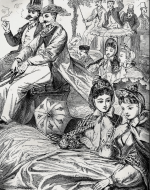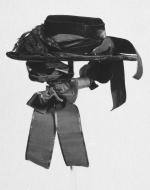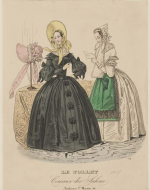Created by Augustine Goebel on Tue, 02/18/2025 - 11:40
Description:
In Victorian England, headwear was as much an indicator of status as it was a fashion statement. Women's hats were elaborate and colorful; the more elaborate, the wealthier. During the time of the Great Exhibition, circa 1850s, the most popular headwear for women was the bonnet, which became more structured throughout the early to mid 19th century.
Hats & Headwear Booth-- The Great Exhibition of 1851; Made from cardboard, cardstock paper, salvaged materials.
‘The London Carnival’-- Artist: Walter Crane (1845–1915), Engraver: W. J. Linton. An image showing the wealthy at play in which the artist stresses appearance, particularly hats. The composition focuses on surfaces and texture, with close attention being paid to the elaborate floral accessories attached to the hats: a world where appearance is the primary currency, and leisure its mode of exchange.
Boy's Hat (1840-1850), London, Victoria and Albert Collection. Round hat of green velvet boy's hat with circular brim, trimmed with blue-green feathers and fastened beneath the chin with green ribbons. It has a low rounded crown and slightly curved brim. The feathers, which are decorated with fragments of applied silk braid, are bunched on the right side, and there is a bow at the back. On either side of the brim are pendant velvet bows, one with silk ribbons.
Le Follet, Courrier des Salons (1837); From Un Journal des Modes, or a fashion magazine, in Paris, France. It was one of the longest-running of all fashion magazines which contained hand-colored plates. Its plates were issued in The Lady's Magazine from the 1830s, the first British magazine to import French plates. The bottom inscription appears to read "Boulevard St Martin, Gt."





